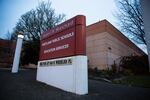Before announcing a sixth school, Jefferson High School in North Portland, was moving to temporary distance learning Tuesday evening, Portland Public Schools officials provided an update to the board.
With a handful of Portland schools, four high schools, a middle school, and a K-8, in distance learning over the next several days, PPS chief of staff Jonathan Garcia announced a return to sports and performing arts at those schools, with a limited number of spectators allowed.
There will also be “limited in-person supports” for students at schools in distance learning.
“In-person academic supports to those students who need to successfully complete coursework, and for students who need in-person counseling, resources, or other things,” Garcia said Tuesday.
Portland schools continue to offer meals and technology support for students.
PPS also heard from two health experts from the Multnomah County Health Department on new isolation and quarantine protocols that will be effective next Tuesday.

New isolation and quarantine protocols reflect updated guidance from the Centers for Disease Control and Prevention.
PPS
Under Multnomah County’s new guidelines updated Tuesday, quarantine is shorter for people exposed to or who have tested positive for COVID-19.
Anyone who tests positive for COVID-19 is advised to isolate at home for at least five days.
If a fully vaccinated child or adult is exposed to someone with COVID-19, there is no quarantine required, though wearing a “well-fitting mask” is advised.
A five-day quarantine is advised for people who are unvaccinated or not fully vaccinated, with an additional five-day period of wearing a “well-fitting mask” after that.
If someone develops symptoms of COVID-19, they are advised to stay home and get tested.
In presenting the changes to the board, Multnomah County health officer Dr. Jennifer Vines said the CDC’s updated guidance was based on the infectiousness of the omicron variant.
“There are really two reasons the CDC put forth for this change,” Vines said. She said the timeline is “compressed,” with people typically contagious up to five days.
That may not be true for everyone, Vines said. The other reason for the change, Vines said, was to “lessen the burden” of missing school or work.

Portland Public Schools district headquarters, Portland, Ore., Dec. 15, 2018.
Bradley W. Parks / OPB
Washington and Clackamas counties have also adopted the CDC’s shortened quarantine guidelines. There has been no statewide adoption of the guidelines.
But as PPS and other districts and organizations continue to adapt to the new omicron surge, questions remain.
Among them, why contact tracing continues at the district, despite backlogs and local county health departments ending their programs.
Vines said contact tracing is “under stress,” and that conversations around the effectiveness of contact tracing are ongoing.
“This is something that we’re going to be looking at really closely to figure out, what is the best use of the resources that we have that’s going to minimize - we’re never going to eliminate the risk of COVID in our schools, but what’s going to minimize the risk and keep kids in school, in-person learning,” Vines said.
Garcia said the district continues conversations with state and local health leaders, and will be making a “decision” around contact tracing in the next few days.
Substitute teacher positions continue to go unfilled both in Portland and elsewhere. PPS human resources director Sharon Reese said Tuesday the district’s substitute pool typically has over 900 people, but it currently has around 650. At the same time, the need for substitutes is growing.
At PPS, there were 391 total substitute teacher requests for educators Tuesday, with 160 of those jobs going unfilled. The district said 65 out of 79 paraeducator jobs went unfilled.
There are also no ways for staff with COVID symptoms off-site to get tests through the district. While there are multiple ways for asymptomatic staff to get tested, district employees showing symptoms are asked to stay away.
In addition, school board chair Michelle DePass raised the question of why schools serving some of the district’s most vulnerable students have been the first to move to remote, and what resources could be directed towards those schools.
Supt. Guerrero called it “troubling” and “vexing.”
“We know not all communities have been impacted similarly,” Guerrero said. “There’s been disproportionate impacts.”
